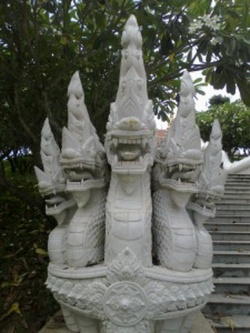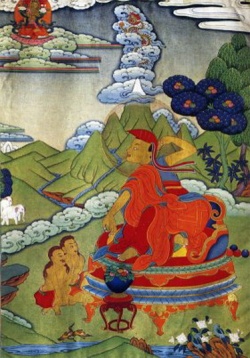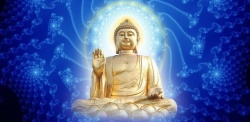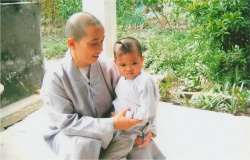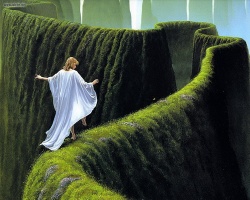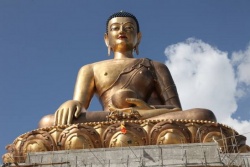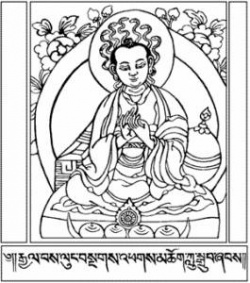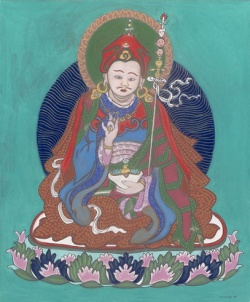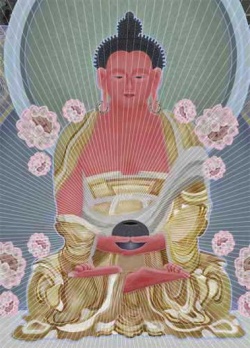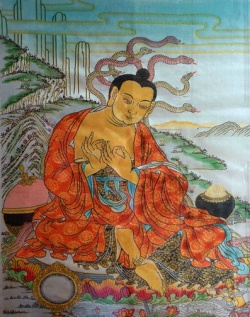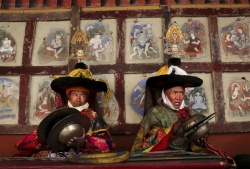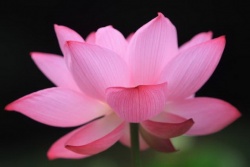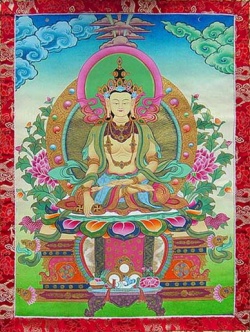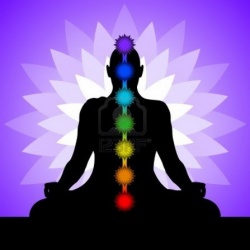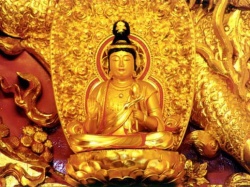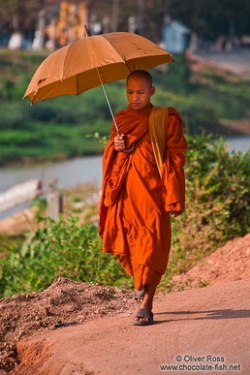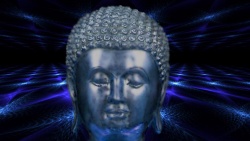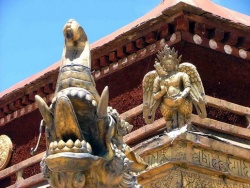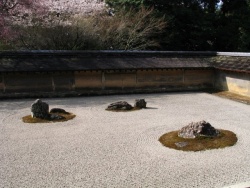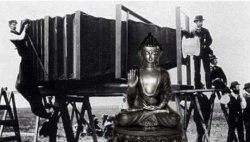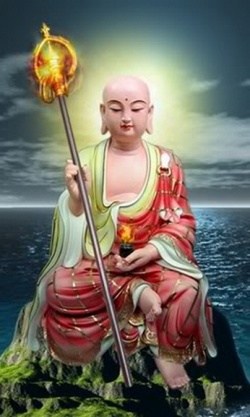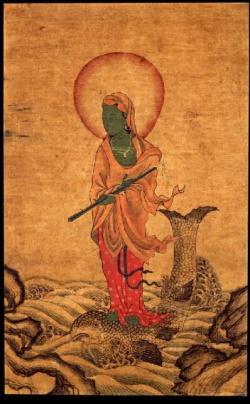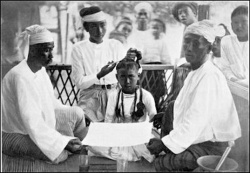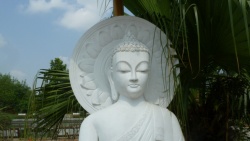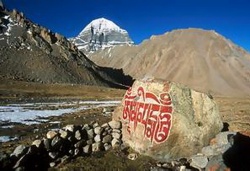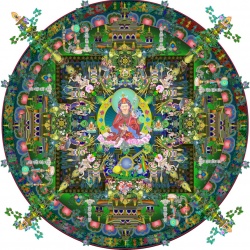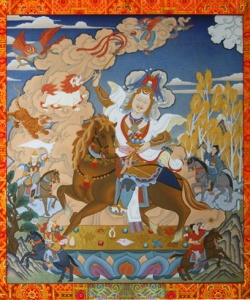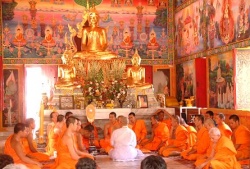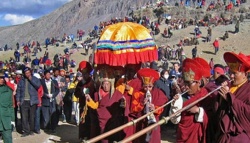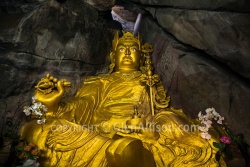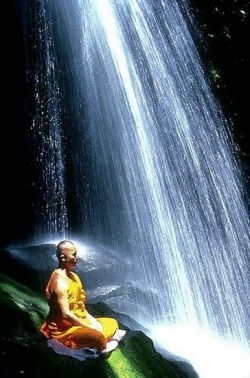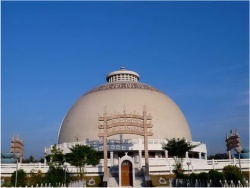Nature and Identity of the Texts in the Sacred Traditions of Buddhism
Professor Augustine Pagolu
South Asia Institute of Advanced Christian Studies, Bangalore.
To establish the nature of religious texts in the Indian context is huge task as it has been the birthplace for many living religions, some of them having large number of undefined religious literature. India is barely 50% literate and most of them do not know what their Scriptures are, not to talk about their contents.[1]Why are we Christians interested in others' Scriptures? My interest in this subject began as I saw many Indian Christian theologians started using Hindu and Buddhist texts to explain certain NT passages and claiming that we might use our own religious traditions instead of the OT which is alien to both our contemporary times and native culture. It does make sense, but my immediate question was, in what sense are the Indian religions and culture similar to the NT? Ironically, Indian Buddhism openly rejects all forms of Hinduism even though they both have many things in common. Recently, in a mass conversion to Buddhism, thousands of Dalits openly denounced Hindu gods and Hinduism in all its forms. Therefore, what are our criteria to borrow or not to borrow ideas from other religions? On what basis one must compare one religion with the other and for what purpose? One thing is certain that every religion regards its own traditions as sacred. Perhaps this gives us the basis to examine any religious text in order to understand its contribution to the common good of the humanity.
In what follows we shall explore the nature and identity of religious texts in the sacred traditions of India and in particular Buddhism. Our main aim here is to understand how religious texts come to be regarded sacred or special, inspired or divine and authoritative or binding on the faith and conduct of the religious communities addressed in them. We hope that this would help us understand how a particular text must be interpreted. But the question is, how to read a text to gain access not merely to theological structures of a particular religion, but to the social worlds, or human situation which the texts are addressing? And, how can our reading be both academic and respectful to the religions the texts represent? If religion is something a group of people do together than a set of beliefs and practices, how can we know the factors that contributed to the set of beliefs and practices? In other words, we are looking for a method by which we can understand as to why people wrote those texts that explained their existence in relation to the challenges they faced. The need of developing proper tools for understanding religions is well stated by Jacob Neusner:
… there is simply no coping with the world today without the intellectual tools for understanding religion, not as a theory of another world, but as a power and force in the shaping of this world. Events in Iran and Afghanistan, as to Islam, Latin America and Poland, as to roman catholic Christianity, the State of Israel and USA, as to Judaism, only illustrate that simple fact that most (though not all) of humanity does what it does by reason of religious conviction. [2]
I hope to show how the Buddhist communities engaged in a search for their own identity as they shaped and reshaped their own religious traditions over the centuries.
1. The Nature and Identity of Sacred Texts in Buddhist Tradition
As has been the case with many religious mediators of the world, the stories of Buddha's life and teaching had survived mostly in the form of legends in many oral traditions for several centuries before they were committed to writing. A continuous story, or the full biography, of the Buddha is not to be found in the Buddhist Scriptures, but in the Chronicles, legends and commentaries that were developed later by the Buddhist schools. [3]The idea of a sacred text is intricately related to the process of canonisation and the struggles of the community that was involved in that process. In what follows we shall attempt a brief survey of this process and then we make some observations to see how the community viewed their Scriptures.
The origin and growth of the Buddhist canon appear to be far more complex than that of the Christian canon, but it is undeniable that Buddhism, like Christianity, has its records of history, archaeological remains and, above all, the Buddhist community with their schools and systems from a long time. Buddhism, it appears, began with a society, or Order, rather than with a body of doctrine. While we cannot be certain about the date of Buddhist canon, we can be reasonably certain about the existence of the eighteen Buddhist schools before the end of the second century BCE, which is about three hundred years after the death of Buddha. It was among these schools, or Orders, that the canon of the Buddhist Scriptures had been gradually developed and the first of which was obviously to be a body of 'rules' for these Orders, called the Vinaya Pithaka. [4]But the Buddhist Scriptures we now possess are extant in three (or four) different languages and our knowledge about Buddhism as well as the process of canonization comes to us primarily from these different language canons and from some non-canonical works, also survived in different languages, all together in hundreds of volumes.
2. The Buddhist Canon
Buddhist canon as a whole or portions of it is extant in four different languages. Almost all the language canons agree on the basic three divisions of the Buddhist canon although numerous variations are to be found in the different collections of different schools. Differences in particular tradition can be seen in the handouts, but we shall describe here the common features that are generic to all the canons extant in different languages. The three divisions are as follows:
The Vinaya Pithaka (The Rules or Discipline Basket), the Dhamma or Sutra Pithaka (The Doctrine or Teaching Basket) and the Abhidhamma Pithaka (The Reflections or Commentaries Basket), and together they are called the Tripithakas (Three Baskets). The structure and the meaning of these divisions suggest, even as the history of the development of the canon reveals, that their present form is a result of 'centuries of labour' on the part of each Buddhist school. As we shall see later, individuals or groups of bhikshus (monks) were committed to specialising in each of these divisions or disciplines for studying, reciting, teaching and transmitting them to others.[5]
However, these three disciplines as we have them now do not feature in the earliest texts, and the name, Tripithaka, as referring to the canon is not to be found in the Scriptures themselves, but was found on the Brahmi inscriptions and the earliest of them comes from the 2nd century BCE.[6]However, post-canonical literature does use the term tripithaka in different ways referring to the canonical Tripithakas.[7]
2.1. The Structure of the Vinaya
Besides the Pali Vinaya, we have five recensions of it, all in Chinese translations from the original Sanskrit.[8]Although there is common core to it, the materials in each Vinaya are quite varied from the others, and the contents of this common core seem to have been developed from the rules (Pratimoksha= list of offences and the corresponding punishments) and ceremonies (Karmavachana= membership, ordination, confession, and retreats) that governed the earliest Buddhist schools as these form the basic content of each Vinaya. Accordingly, the generic Vinaya contains the following two sections and an appendix.[9]
1. Sutravibhanga: This has two sections, rules for the monks and for the nuns arranged separately, and each rule followed by a systematic commentary explaining the history of its promulgation, sometimes with extensive legends and anecdotes, describing the rule and prescribing penalties of violation, and concluding with any exceptions. [10]
a) Rules for the monks (Bhikshuvibhanga), 227 articles arranged in 8 categories:
i. Parajika or Apatthi, offences leading to expulsion.
ii. Samghavashesha (Pali- Samghadisesa), offences leading to expulsion from the community.
iii. Aniyata, undetermined offences.
iv. Nihsargika Patayantika (Pali- Nissaggiya Pachittiya), offences leading to giving up an object that has been acquired wrongly.
v. Patayantika (Pali- Pacchittya), offences requiring penance.
vi. Pratideshaniya (Pali-Patidesaniya), offences requiring confession.
vii. Shaiksha (Pali-Sekhiya), matters to be recommended.
viii. Adhikaranashamatha, ways of settling quarrels.
b. Rules for the nuns (Bhikshunivibhanga). This contains 311 articles arranged in seven categories, but the contents are the same as the above with the absence of the third category, Aniyata.
2. Skandhakas ('sections'), or Vastu ('points', Pali- Khandhakas): Here there are further regulations for governing the monastic life on the basis of the ceremonies laid down in the Karmavachanas above. These are in 20 sections arranged as follows:[11]
i. Pravrajya- membership; ii. Poshadha- monthly confessional ceremonies; iii. Varsha- monks retreat during the rainy season; iv. Pravarana- feast following the retreat; v. Charma- the use of leather article including sandals; vi. Bhaishajya- medicines; vii. Chivara- clothing; viii. Kathina- distribution of monastic garments; ix. Koshamba- quarrels among the monks; x. Karma- rules to be followed in the monastic order; xi. Pandulohitaka- disciplinary measures in the order; xii. Pudgala- procedures against minor offences; xiii. Parivasika- rules during probationary period; xiv. Poshadhasthapana- a monk's exclusion from the confessional ceremony; xv. Shamatha- procedures for settling quarrels; xvi. Samghabheda- schism; xvii. Shayanasana- dwellings and furniture; xviii. Achara- monks' behaviour in different circumstances; xix. Kshudraka- minor recommendations; xx. Bhikshuni- procedures for nuns.
3. The Appendix. Not all Vinayas contain this third section, which is basically a summary of the previous two sections with additional information on the history of the Buddhist schools. The stories of Buddha's genealogy, birth, and the events immediately following Buddha's enlightenment receive a major attention- his first preaching and the first disciples, Saruputra and Maudgalyayana, and the rules about schism. While this is a repetition of the previous sections, many legends have been drawn from the Skandhakas and many discourses from the Agamas in order to reinforce the points made in the previous sections and to relate how certain acts of misconduct of the monks led to the promulgation of certain rules. This section also deals rather abruptly with a chronicle of the first council at Rajagriha and the first patriarchs following Buddha's decease and funeral and finally the council at Vaishali.
2.2. The Structure of the Sutrapithaka or Dharma
This is the most important part of the Scripture for all Buddhist schools since this was the main teaching Buddha discovered through his enlightenment. Nevertheless, the structure, nomenclature and even the contents differ in different schools. It contains five sections in Pali (called Nikayas) and in certain Sanskrit-Chinese (called Agamas) traditions, [12]but most of the early Sanskrit traditions have only four. [13]The structure and nomenclature of them are as follows:
1. Dirghagama, 2. Madhyamagama, 3. Ekottaragama, 4. Samyuktagama, 5. Kshudrakagama. And in Pali, the last three syllables of the names, agama, are replaced with, nikaya, and in the third section, instead of Ekottara you find, Anguttara, yet with the same five sections. The arrangement of these collections is according to the length of the sutras or the method of their classification in each case. Thus Dirghagama is the collection of 'long discourses' and Madhyama is 'medium length', and Samyukta is 'grouped or connected', Ekottara (in Pali, Anguttara is 'numerical') is…, and the Kshudraka is the 'minor' discourses. Nevertheless, those schools that recognise all five sections maintain that the fifth section contains certain minor texts even as the name, Kshudraka, indicates and is thought to have been added to the collection later. However, certain schools added this section to their Agamas but, for unknown reasons, called it pithaka, thus Kshudrakapithaka. [14]But the major difference is with the schools that reject the minor texts, Kshudrakanikaya, and recognise only the first four sections of the Sutrapithaka and again no reasons given for this. The canon of one of the dominant schools, the Sarvastivadins, not only contains certain portions of the minor texts but also resort to using them often as if they were canonical or deutero-canonical. [15]And the Mahayanists who derived their Scriptures from the Sarvastivadins make this in to another pithaka resulting in four pithakas instead of the traditional tripithakas. [16]
While we have no Sanskrit originals in their totality, fragments of various Agamas are found in Sanskrit and Middle Indian in Central Asia and in the caves of Tun-huang in Kansu between the 6th and 11th centuries CE,[17]but large quotations of the originals, with or without references, are found in later Buddhist writings and commentaries [18]However, a complete Sutrapithaka, as well as the other two pithakas, are extant in Chinese translated between 4th and 5th centuries CE by the Kashmirian monks, but none of them comes from the Pali. [19]
The Content: The Buddhist Dharma, or teaching, is the main subject matter of the Sutrapithakas, especially the first four Agamas although some sutras deal with discipline like the Vinaya, and lists of principles like the matikas of the Abhidharma. Sometimes the same subject is dealt with repeatedly almost in identical fashion and the same sutra appearing in long or short discourses in different collections. [20]However, there are major differences between the Pali and the Sanskrit collections. First, the Agamas, being the later collection than the Nikayas, seem to have made room for the growing literature of the various Buddhist sects. For instance, the Samyukta (T-99, ch. 23, pp. 161-70) include large extracts from the Ashokavadana. Secondly, the introduction, nidana, does not agree with each other in their settings. Thirdly, the number of sutras in each Agamas are not the same as that of the Nikayas as the latter seem to have added in some places and deleted in others, and in yet others even relocated some of them. For instance, the Lakhana- and Samghitisuttanta, and the Mahaparinirvana- and the Mahavadanasutra. [21]Nevertheless, it is observed that there is a remarkable agreement between the agamas and the nikayas in regard to the doctrinal basis common to them, and the theme 'Anatman' (devoid of substantial reality), according to Lamotte, is the best example and 'the only proof of the authenticity' of the nikayas in this regard: 'Any attempt to reconstruct a 'pre-canonical'Buddhism deviating from the consensus between the agamas and nikayas can only end in subjective hypotheses.' [22] The Kshudrakagama (Khuddakanikaya in Pali), as noted above, is to deal with the minor texts and it is here the difference between the various schools is felt the most. According to certain 5th century CE chronicles the Kshudraka traditionally contains 15 sections in Pali (the Samantapasadika, p. 18, 27, 1.23, but the Chinese version of the same deletes the first section and lists only 14; the Sumangalavilasini, p. 17, 23, 1.25), but the Atthasalini of the same period mentions a Kshudraka with 15 sections and the another with 14 (p. 18, and 26, 1.3). The other differences of more substantial nature are concerned with deleting some, adding others or relocating the whole to other parts of the canon. [23]However, a number of scholars argue that the canonicity of the Kshudraka need not be questioned since some sections of it either have been used by earlier parts of the canonical works or mentioned in a number of other Buddhist literature, although the claim of certain Sinhalese tradition that the Kshudrakanikaya was part of the canon from the time of the first council at Rajagriha cannot be accepted.
With regard to the contents of the Kshudraka, they were never uniform in different schools. The confusion supposed to have begun from the very first council where the dilemma was whether to accept the texts in it that were not in conformity with the Agamas, and whether the Kshudraka can be identified with the 'Twelve-fold Word of Buddha'. The Chinese translations of the Kshudraka confirm this fact in various ways: some say that the accounts of the Kshudraka differ in thought and actions but they abound in Gaatha (epic in stanzas) and deal with Buddha's previous births (jatakas) and their causes (nidana) in the course of three countless periods as explained by the Buddha, the Arhats, Devas, Brahma and the Tirthikas. That is why they are called Tsa tsang (Kshudrakagama); others go at length insisting, on the basis of this content, how the Kshudraka must form part of Buddha's Word. [24] The fact that there is no complete Kshudraka either in Chinese or in Sanskrit schools suggests that their claims to its being the word of the Buddha is secondary to the narrative and the number and structure of the sections in different schools is artificial in order to make up for what is lacking in its Pali counterpart. [25]
2.3. The Structure of the Abhidharmapithaka
Originally this third division was called the Matika which simply means 'summary' or 'lists of subjects' discussed under it. Only the first two pithakas are mentioned in the accounts of the first council, but not this one.[26]However, some sources, including Hsuan tsang, attribute it to Kashyapa without informing where and when this was undertaken, [27]while a majority of sources attribute it to Ananda as having recited it at Rajagriha although they do not agree on the number of sections it contained. [28]On the other hand, there were number of schools that did not recognise Abhidharma as the word of the Buddha, although some of them, like the Mahasamghikas, still made use of it. [29]
Among its various recensions now extant, the Abhidhamma of the Theravadins and the Sarvastivadins are the most important. In both schools, it contains seven sections, but serious differences still remain in regard to its origin, date and the contents.
First, the Abhidharma of the Theravadins: The seven sections of this collection have no correspondents in the Sarvastivaasins.[30] As late as Buddhaghosa's time Theravadins added certain episodes to the legends of Buddha in order to establish Abhidharma's authority. Accordingly, Buddha supposed to have grasped its message at the Bodhi tree and put it together in the fourth week after the Nirvana. But this is contradicted by another Sinhalese tradition which relates that the Kathavatthuppakarana, the fifth section of the Abhidhamma, was revealed to Moggaliputta Tissa 236 years after the Nirvana at the council of Pataliputra. [31]In order to explain this contradiction to certain critics, Vitandavadins, who rejected Kathavatthu being the word of Buddha, the Theravaadins added another tradition explaining that Tissa merely elaborated on what was already given in summary by the Master.[32]
Secondly, the Abhidharma of the Sarvastivadins: As mentioned above, the number of sections remains the same as in the Theravadins, while their names are completely different and the whole is titled as Shadpaadaabhidharma, 'the Six-feet Abhidharma'. One of the sections, Jnaanaprasthaana, is designated as the body, 'sharira', and the remaining six sections [33]being the feet, 'paada'. Unlike the Theravadins, they believed that it was not at the Bodhi tree but in Sarvasti that Buddha initiated Abhidharma, and it was not compiled by Buddha but he authorised his disciples who compiled it at different times and places. [34]The Chinese translations that have been largely derived from the Sarvastivaadin tradition have some interesting information on the Abhidarma texts. While Kumaarajiiva, in about 404-405, attributes the Jnaanaprastaana (T-1543, 1544) to a wise Brahmin monk, Kaatyaayana, who composed it after the emergence of the sects which occurred 100 years of the Nirvana, [35]Paramaartha in his two works attributes Abhidharma to certain Kaatyaayaniputra but dates him in two different periods. [36]On the other hand one of the Vibhaasha's (T-1545, ch.1, p. 1), trying to harmonise this contradiction attributes this work to Buddha who originally expounded it in various places and it was his disciples, through 'pranidhijnaana', 'aspiration' (or 'inspiration'?), and 300 years later Kaatyaayaniputra, by the same method, edited it. [37]We can see how the community is explaining the authority of their traditions.
Besides these, there is something known as the Saariputraabhidharmashaastra (T-1548) which contains four sections according to one tradition and nine according to another.[38]The Abhidharma known to Hsuan tsang and his disciples and the Tibetan historian Bu-ston, contains the traditional seven sections and they attribute each of its sections to different authors who compiled them at different places. [39]
Thirdly, the contents of the Abhidharma: As we noted above, the title simply means, 'summary' or 'special dharma'. However, the content of the Abhidharma is different in different schools although they all claim to be the summary and substance of Buddha's teaching in the Sutrapithaka. It may be more appropriate to call them as commentaries of different schools on the Sutrapithaka than a separate pithaka. For instance the Dhammasangani of the Theravadins is a commentary of the previous sections while the Vibhanga is a partial repetition of the former. Similarly, Kathavatthu is a polemic against the 26 different heretical schools including that of Mahadeva of Ashoka's time, and the Vetullavadins of late third century CE. This may be the chief reason why the Sinhalese schools were hesitant to assign it a place in the canon until the fifth century CE. Thus some monks formed the third pithaka out of it, while others appended it to the Khuddhakanikaya, the fifth section of the Sutrapithaka. [40]Lamotte rightly observes that the 'Abhidhamma abounds in repetitions, rectifications, reclassifications and explanations which give it the character of an unfinished work still in the process of elaboration'.[41]He further says that the sources of these traditions must not be 'overestimated. Despite their supposed canonicity, the Abhidharmas are the works of schools and it is only through contrivance that they are connected with the Buddha and disciples contemporary with him'. In what follows we shall have a brief look at the sources that describe the intentions and convictions of the schools who gave a structure to their Scriptures in their different councils as we have them now.
3. The Councils, Heresies and Schisms
3.1. Sources
First, the sources that report only about the first council come from the late Hinayana and Mahayana sutras and do not form part of the canonical collections of the Agamas or Nikayas. Among these are sutras from i) Kasyapasamgitisutra; ii) Parinirvanasutra, and iii) 'The Narrative of the compilation of the Tripithaka and the Tsa tsang'.[42] Among the Mahayana writings, the account appears in the Vaipulyasutras and Shastras, such as i) Fin pieh kung te lun ii) the Ta chih tu lun iii) the P'u sa ch'u t'ai tang and iv) the Ta pei ching.[43] Interestingly, Mahavastu, which forms part of the Vinaya of the Lokottaravadins, also relates an account of the first council, to the exclusion of the second following a brief account of the funeral rites of Buddha. All of them show the intention of presenting the writings as authenticated by their council, all of them contain mythic figures, such as Govampati, the ox-god, attending the council, and all of them seem to ignore the second council.[44]
Secondly, the sources that report on the first two councils are found in all the Vinayas, the first being in the year of Nirvana while the second 110 years afterwards, but they appear as later insertions in to the texts. While the Vinayas of the Pali (ii, pp. 284-308), Sarvastivadin (T-1435, translated by Kumarjiva in 404 CE), and Mahishasaka ( T-1421, ch. 30, pp. 190b-194b), give a rough and abrupt account of the two councils, the Vinayas of Dharmaguptaka (T-1428, ch. 54, pp. 966c-971c), Mahasamghika (T-1425, ch. 32, pp. 490b-492c. ch. 33, p. 493a-c) and Haimavata (T-1463, ch.3-4, pp. 818a-819c 13) give a brief account of Buddha's decease and funeral rites before they report on the councils.[45] The concern of these accounts, like the ones of the Hinayana and Mahayana, is to find proof and authority for the councils that decided over the matters of the canons of their Scriptures. It appears that the idea of canonicity for them is not so much to do with the words of Buddha as originally given and valid for faith and practice for the Buddhist community as a whole, but to do with the writings/traditions preserved by the members of their own schools that are considered as Scriptures. This is captured well by the Pali Vinaya account where Purana, the leader of 500 monks from Dakshinagiri, expressed reservations over what was approved by the first council and 'claimed that he had memorized the Law as he had heard and received it from the very lips of the Blessed One'.[46] Another concern of these accounts is also interesting, in that the accounts are more concerned in the rules of the Vinaya than the doctrines of the Dhamma.
Thirdly, an interesting report of the first two councils has been related in somewhat parallel accounts of the Avadanashataka and the Mulasarvastivadin Vinaya. The concern of these sources appears to be not only to establish the antiquity of the canonical traditions, but also to ensure in the traditions that they were transmitted faithfully over the years. For instance, the Ashokavadana of the Avadanashataka maintains in its two recensions[47]that the first council (they do not mention the second) was held at Rajagriha following the death of Buddha, and the Dharma Baskets were delivered to the first five or six patriarchs- Kashyapa, Ananda, Madhyantika, Sanavasa, Upagupta and Dhitika- in order that they might transmit them to the future generations. The parallel account is found in both the Chinese and Tibetan versions of the Mulasarvastivadin Vinaya. The Chinese version (T-1451, ch. 35-40) translated by I-ching in 710 CE, maintains that the first council was held following the decease of Buddha and the responsibility of transmitting the Law was given to the eight patriarchs- Mahakashyapa, Ananda, Madhyantika, Sanavasa, Upagupta, Dhitia, Kala and Sudarshana. And the Tibetan version adds that the second council was held 110 years after Nirvana with the generous help of the King Ashoka.[48]
Fourthly, we come to the well known Sinhalese chronicles, Dipavamsha and Mahavamsha and the commentaries of the 4th-5th centuries CE. The Dipavamsha (The Island Chronicle, from about 4th century CE), the earlier of the chronicles, relates two accounts of the first council (ch. iv, 1-26; ch. v, 1-15) and two of the second (ch. iv, 47-53; ch. v, 16-29). It dates the first council in the year of the Nirvana at Rajagriha, and the second council to 100 years after Nirvana at Vaishali which supposedly led to the Great council (mahasamgiti) of the rebellious Vajjiputtakas of Vaishali, who changed the original writings in their content and order and added their own collections and meaning that further led to the division of the community into eighteen different sects (ch. v, 30-54). The Mahavamsha (The Great Chronicle, from about 5th to 6th centuries CE) devotes a chapter each to the first and the second council (ch. iii and iv, respectively) and another chapter (ch. v) to the transmission of the traditions, the history of the King Ashoka and the council of Pataliputra (ch. v, 228-82). Another chronicle, Samantapaasaadika, gives the account in the order of first council, the transmission of the traditions, the second council 100 years after the Nirvana, the reign of the King Ashoka and the third council 236 years after the Nirvana. [49]Interestingly, the last two chronicles present the accounts neatly but do not mention about the schism and the consequent Buddhist schools.
Fifthly, we have two sources from Chinese pilgrims from about the same period and a contemporary source from an Indian author that throw considerable light on the accounts of the chronicles. First, Fa hsien, the Chinese pilgrim, in his memoirs collected from oral traditions during his travels in India in 399-412 CE, confirms that the first council was held in Rajagriha and that in Vaishali the traditions were re-examined by the 700 arhats, but he makes no mention of the schism (T-2085, pp. 862a, 863a). Secondly, Hsuan tsang is the other Chinese pilgrim who visited India during the year 637or 642. From his memoirs of the oral traditions collected in India, Hsuan tsang relates that in the year Buddha died the first council was held in Rajagriha where the Buddhist writings were compiled by a 1000 arhats under the leadership of Sthavira Kashyapa and the collection was known as Sthaviranikaya. In the same year a large number of monks, unordained or arhat, who were not admitted in to the assembly of Kashyapa met together in a separate place and compiled the Scriptures called Mahasamghikanikaya (Collection of the Great Assembly) which contained the Vinaya, Dharma and the Abhidharma, plus the supplementary texts, such as the Samyukta (Mixture) and the Dharani (mnemonical formulas). Then he tells about the second council having been held 110 years after the Nirvana where 700 sages met and condemned the unorthodox practices introduced by the monks of Vaishali and made a second compilation of the writings, and he mentions the names of some of the members of the council as former disciples of Ananda.[50] Interestingly, some of these aspects are confirmed in an Indian tradition coming from about the same time. According to the Indian, Paramartha (500-569 CE), and confirmed by his Chinese disciple Chi tsang (549-623), following the death of Buddha the Buddhist writings were compiled simultaneously by two assemblies in separate places; one of 500 arhats led by Mahakashyapa and the other of 10, 000 members, the Great Assembly (mahasamghikas), led by Bashpa, one of the first five bhikshus, but there was no schism mentioned at this stage. However, it tells about a schism on account of doctrine 116 years later when the five-fold heresy of Mahadeva was adopted by the Mahasamghikas and which was condemned by the Sthaviras.[51]But this latter tradition does not seem to know about the council in Vaishali. However, before we draw any conclusions on the date, content and the implications of the sources and their contents for the Buddhist writings, we shall look at briefly how the sources deal with the councils they mention.
3.2. The first Council
This is also known as the council at Rajagriha which was held in the first year after Buddha's death and dated in 486 BCE on the basis of the Pali Vinaya (ii, pp. 284-308) text that places the consecration of Ashoka 218 years after the Nirvana.[52]The first council is found in all the recensions of the Vinayas, but it appears as a later addition. In the Pali Vinaya it comes rather abruptly at the end of the Khandakas which is actually the end of the Vinaya, because the next section Parivara, which now forms the end of the collection was composed by a monk, Dipa, in the 5th century CE. According to this tradition the occasion was the reaction of the monks following the death of Buddha and, in particular the reaction of Subhadra who 'openly rejoiced at the loss of the Buddha who exasperated the monks with his observations; he proposed that the bhikshus (monks), now free of all restraint, should live as they liked'.[53] In order to maintain the discipline of the Order, the elder Kasyapa calls for a council at Rajagriha, the capital of Magadha, with 500 arhats including Ananda who was well versed with the teaching of Buddha, although not yet attained arhatship. The text says that Ananda experienced a sudden enlightenment and attained arhatship just before the council opened its session. Then Kasyapa questions Upali on Vinaya Pithaka, and Ananda on Dhamma Pithaka,[54]the first two main sections of the Scriptures, in order to verify if these disciples knew the exact context, the place and the people involved when Buddha made these rules in these two Pithakas. The assumption is that each article of theVinaya and the Dhamma presumed to have had an introduction (Nidana) where such things have been related. However, Ananda reveals to the council that he had heard Buddha saying before his death that the community could do away with certain minor rules, but he did not ask the Master which ones he meant. As the council could not reach an agreement on the issue, Kasyapa proposed that all the sutras must be given equal importance, which the council adopted unanimously but Ananda was disciplined by the council for failing to ask Buddha on those minor points, and for certain other mistakes he made including his proposal for the entry of women into the Order.
However, there are a number of discrepancies in regard to various details of the council. First, although the council is dated to the first year of Buddha's Nirvana, the date of Buddha's death differs significantly in different sources.[55]three other places are attested as the location of the council.[56]Thirdly, the number of monks attended the council was put at 1000 and 3000 by two Chinese sources respectively.[57]It is also doubtful if Buddha had such big following with such an organised system before his death. Fourthly, while the traditions unanimously attribute the compilation of the Scriptures to the council, many texts in the collection refer to events and dates later than Nirvana and even later than the council. For instance, several sutras in the Madhura, the Ghothamukha, the Gopakamoggallana show that they came after the Nirvana, while the Narada seem to suggest that it was composed during the reign of Munda the grandson of Ajathashatru, and Assalayana mentions the Yona-Kamboja of the Graeco-Bactrian and the Yueh-chih of the Kushana times that date after the council,[58] suggesting that either these texts were not part of the collection the council approved or the stories about the council were inserted into the texts later in order to suppress or explain any questions about their authority.
Fifthly and more importantly, several traditions in the collection disagree over the extant of the canon approved at the council, especially the extent of the Vinaya, the number of suttas in the Nikayas and the place of the Nikayas in the Dhamma Pithaka, and whether the Abhidhamma formed part of the collection at all at this council. For instance, both the Pali and the Sanskrit Vinaya, the first major division of the canon, agree on the number of sections they contain, namely four, and on the contents of the first two sections although the names are different. However, the third and fourth sections of the Sanskrit Vinaya are very different from their Pali counterparts both in name and content, and the Pali's third section, Parivara does not feature in Sanskrit at all. In the second major division of the canon, the Dhamma Pithaka, Pali has five sections called Nikayas, while Sanskrit has four and are called Agamas.
It is interesting to note that the third major division, Abhidhamma Pithaka, does not feature in the story of the council, which might suggest that either there were no questions about its canonicity or it was non-existent, as many scholars think that the latter may have been the case. Perhaps the extent of its contents in various canons points toward this conclusion. For instance, it contains seven sections in both Pali and Sanskrit, but the latter exists now only in Chinese translations and is attributed, unlike the Pali, not to Buddha but to his disciples, of whom only four were recognised by the Pali compilers, the Theravadins. Further, neither the titles nor the contents of these sections (excepting one Dhatukatha (Pali) and Dhatukaya (Sanskrit)) have anything common among them. They seem to have developed much later than the first two Pithakas. For instance, the Kathavattu, the third section of the ?Abhidhamma was not compiled until the year 236 after the Nirvana. [59]It is probably unrealistic to expect them to have been compiled at a time when the Buddhist schools themselves were not yet formed.
Sixthly, as we observed above, each article of the Vinaya and the Dhamma had a Nidana (introduction) explaining the circumstances in which they were promulgated in to the canon. But it is observed that the nidanas of various sutras differ in different canons. For instance, the nidana of the Brahmajalasutta of the Pali Vinaya (ii, p. 287) tells us that it was given in the royal pavilion of Ambalatthika, but two Chinese versions of the same sutra, Changa han (T-1, ch. 14, p. 88b 13) and the Fan wang (T-21, p. 264b 1) locates the occasion in Venuvana and Kareri respectively. Another example is the introductory formula to the Chinese recension of the Mahaparinirvanasutra (Ta chih tu lun, T-1509, ch. 2, p. 66c) claims that it was Buddha's order that the 'precious basket of the Law begin with the formula 'Evam maya srutam ekasmin samaye: The Buddha was residing n such-and-such a region, such-and-such a country, such-and-such a grove'. But the earlier versions of the same law did not mention this rule, suggesting that these introductions were not part of the original composition. [60]
3.3. The second Council
According the Sinhalese Chronicles (Dipavamsa ch. iv and Mahavamsa ch. iii) the second council was held between 100-110 years after the Nirvana (that is, 386-76 BCE), although two Chinese sources from Sanskrit originals and the Chinese historian Hsuan-tsang place this council in 258 BCE, which is ten years after the consecration of the king Ashoka.[61] The occasion for this council was to resolve a dispute over the ten practices adopted by the monks of Vaishali 100 or 110 years after the Nirvana, which were thought to have been contrary to the teaching of the Master. Much of this story is of legendary in nature and the accounts of the story in Dipavamsa and Mahavamsa differ in details, such as the date, the place they met, the number of the monks involved and the points of dispute. First, various sources date the event variously between 100 to 228 years after Nirvana during the reigns of Nandin, Kalashoka and Ashoka of the Maurya. Secondly, different places are given where the event supposed to have taken place: three different places in Vaishali, namely in the monastery of the Valikarama, in the monastery of the Kusumapura, in the Kutagarashala of the Markatahradatira; one source, without mentioning the name of the town, states the place as the Vihara of Kusumapura. Thirdly, the number of monks attended the council were 700 and 1, 200, 000. Fourthly, all the elders of the council knew Buddha 'and at the time of these events had been ordained for 110 to 130 years'. Fifthly, while there was no chairman for the council, at least four different individuals, namely Revata, Sambhuta Shanavasin, Sarvakamin and Kubjita, were referred to as those who assumed leadership in making decisions at various points. Sixthly, the eight elders, four from the East and four from the West, chosen arbitrarily to decide over the legitimacy of the ten practices of the Vaishali monks, seem to have come mostly from central India. Seventhly, the ten practices of the Vaishalians were interpreted differently in different sources before condemning them. But all the sources agree in condemning the practices, except the Mahasanghika Vinaya that condemns only the last practice that allows the bhikshus to receive gold or silver from their benefactors.[62]
3.4. The Third Council
The story of the third Council,[63]another legend in form, comes mainly from Sinhalese sources coming from 4th century CE and later.[64]The Council is dated both from the perspective of Buddha's death (236 years after) as well as Ashoka's reign (in the 17th or 18th year), which is 250 BCE.[65]However, Dipavamsa gives another date contradicting its own previous reference while Buddhaghosa puts the event 218 years after the Nirvana.[66]The occasion for the council was to refute certain heretics who had infiltrated the ranks of the order claiming that Buddha taught radical eternalism, partial eternalism, scepticism and the like, sixty-two heretical theories in all.[67]Ashoka supposed to have called for the council with the help of Moggaliputtatissa (Ashoka's own brother), and haviving examined the matter, condemned, derobed and expelled the 60,000 heretic bhikshus. Having been assured by Moggaliputtatissa that the right teaching of Buddha was Vibhajyavaada (of distinguishing), Ashoka proposed to celebrate the uposhatha with those 60,000 (6,000, 000 in a Chinese recension) orthodox bhikshus.[68] Then with the help of a 1000 monks, well versed in the Scriptures, Tissa made the third compilation of the Dharma and the Vinaya in nine months in the manner of Kashyapa and Sonaka who had compiled the Scriptures at Rajagriha and Vaishali respectively. Interestingly, the Pali sources claim that Tissa had suddenly produced the Kathaavatthu during the middle of the session in order to refute the heretics, but the Chinese recensions lack this information.[69]A number of scholars have raised several questions in regard to the council and its achievements. First, Ashoka's direct intervention in the religious disputes has been seriously doubted, as we shall see below, in the view of his impartial policy toward all religions. Secondly, since only the Pali sources mention about the council, it must be a local tradition. Thirdly, to attribute Vibhajyavaadin philosophy to Buddha is to commit anachronism since this particular version belonged to a later sect.[70] Fourthly, the sources commit another anachronism by attributing to Moggaliputtatissa the Kathavatthu where the Andhaka sect that was yet to appear was condemned.[71] Some scholars think that this story was invented in order to prove the authority of the Kathavattu which was not featured in the previous councils. On the other hand, the Mahavamsha elsewhere and its earlier counterpart, Dipavamsha (4th century CE), record in identical terms that it was in Sri Lanka under the King Vattagamani Abhaya (29-17 BCE) the Buddhist teachings were first recorded in books: 'Before this time, the wise Bhikkus had orally handed down the text of the three Pitakas and also the Atthakatha. At this time, the Bhikkus who perceived the decay of created beings, assembled and in order that the religion might endure for a long time, they recorded in written books.'[72]
4. The Mahaadeva Heresy
A well known heretic, Mahaadeva, seem to have taught a controversial 'five-theses heresy' that challenged the rights and privileges of the orthodox arhats and thereby set in motions a heresy that permanently divided the sect. This is variously dated by different sources. The fivefold thesis goes like this: 1. Arhats are always subject to certain bodily passions and impurities; 2. Arhats are still subject to ignorance, and on account of this, 3. Arhats are still subject to doubt. It is said that even Saariputra and Maudgalyaayana did not know that they attained arhatship until Buddha revealed it to them. 4. Arhats need others' help in their spiritual life. 5. The Nirvana is possible by other means besides the eightfold path. In essence this heresy seems to focus on a democratisation of the community.[73]This is described in both Pali and Sarvastivadin Abhidharma and in several Chinese sources, but they disagree on the date of the heresy, its originator and the consequences.
The earliest source by Vasumitra, a Sarvastivadin scholar, on the Buddhist sects comes from the first century CE, but it is now extant only in its three Chinese and one Tibetan translations coming from the 5th, 6th and 7th and 9th centuries CE respectively, and is also commented upon by a Chinese source from 7th centuries CE.[74]The heresy is situated at the time of Ashoka but dated 116 years after Nirvana (the Sarvastivadin short chronology). Among the translators, only Hsuan tsan identifies the heretic as Mahaadeva, probably takes it from the Vibhaasha, but all agree on the five-these-heresy and its condemnation and the consequent division of the community into the Mahasamghika and the Sthavira sects.
The second source, the Vibhaasha, again a Sarvastivadin work on the Abhidharma by the Kashmirian monks, comes from the 2nd century CE. Like in the previous source, the heresy is to do with the five heretic theses, but unlike the previous source, the heretic is identified as Mahaadeva and the king is from Pataliputra, but not named. The heretic is vilified and attributed some unpardonable sins (aanantarya) for dividing the community in to the Sthaviras and the Mahasamghikas.[75]
A third group of sources from the Mahayaanist monks who consider themselves in some way successors of the Mahasamghikas, identify the heretic and his theses, dates him, like the Vasumitra, 116 years after Nirvana during the reign of Ashoka but praises Mahaadeva's talent and describes Ashoka taking his side and bringing harmony between the factions.[76]
A fourth group of texts, however, situate the heresy, some in 137 years after Nirvana during the Nanda dynasty (fits long chronology) and some in 160 years after the Nirvana yet dating it to the reign of Ashaka. The latter, however, does not fit with Ashoka's reign by any calculation.[77]
Besides these, there are other sources that mention a second Mahaadeva who carried out the schism further in the mountainous region of Andhra Pradesh, the Pali sources mention no less than 9 different Mahaadevas, but none of them is a heretic.[78]Such varied and contradictory sources suggest for many scholars to doubt the historicity of the Mahadeva, but it is possible that the original story related to heresy and schism might have existed in some form which had been used by different schools adapting to, and/or reflecting on, their particular situations. Therefore, what are we to make of these traditions as they came down to us?
5. The Idea of the Text in the Transmission of the Traditions
In spite of the anomalies of incoherence, contradictions and exaggerations, some Buddhist schools have preserved a neater history of their traditions than that of the others although serious difficulties still remain even within the same school. Apart from the late traditions that give a full history of the transmission of their Scriptures, we have very little information about their schools and their activities immediately following the death of Buddha. The best preserved tradition is contained in the Sinhalese sources but they come from the 4th and 5th centuries CE which is nearly a thousand years after death of Buddha. This gap could be bridged, though not without difficulties, up to the time of Ashoka but the real problem remains between Ashoka and the time of Nirvana even though not everything about Buddhism associated with Ashoka is to be taken seriously. For instance, the majority of scholars doubt if Ashoka was involved in settling the doctrinal differences of the sects as the tradition would have us believe because his many edicts suggest that he tried to protect all religions impartially and he even carved out caves near Gaya for non-Buddhist monks (the Ajivikas who were more like the Jains). One of his pillar edicts says: 'all denominations are reverenced by me with various forms of reverence'.[79]
Nevertheless, the Sinhalese sources seem to take advantage of Ashoka tradition while at the same time anxious to bridge the gap between Ashoka and the Buddha. For this, first they had developed a rationale and then they went on to explain the history of traditions within its framework. Their rationale said: 'The word of the Buddha is what reaches us traditionally as the word of the Buddha, through the succession of masters and pupils, that is to say what is found in the Sutra, appears in the Vinaya and does not contradict the Dharmata, or nature of things'.[80]This probably means the 'big picture' or the overall teaching of the Buddha that had been passed on from the teachers to the disciples and on to the succeeding generations. Notwithstanding the incoherencies, legendary nature and the late dates of the sources,[81]the Theravadin tradition lists six 'Vinaya Chiefs', 'vinayapaamokkha', who were responsible one after the other for transmitting the rules of the Vinaya from the decease of Buddha to the time of Ashoka in an unbroken fashion with details of each of their date of birth, year of ordination and period of service.[82]It appears that the aim of these traditions is to ensure that this had been undertaken meticulously and faithfully.
However, this tradition makes no mention of the 'Masters of the Law', 'dharmaachaarya', although it contains, rather strangely, a long list of 'Abhidharma Masters' from the time of Buddha's decease to the reign of Ashoka many of whom do not feature elsewhere in Buddhist history and therefore scholars seriously doubt its historical value.[83]The Sanskrit sources from about 2nd century CE of the Sarvastivadins and the Mulasarvastivadins compile a list of five Masters of the Law, 'dharmaachaarya', who succeeded Buddha one after the other in transmitting the Law to the coming generations.[84]These traditions abound in myths and legends and many of them were later translated in to the Chinese sources which introduce further complications in to the traditions with many more legends and contradictions. Besides, there are the reports of the Chinese pilgrims, Fa hsien and Hsuan tsang, who also write about these Masters of the Law in their chronicles. [85]So what are we to make out of these traditions?
It is certain that Buddha had left nothing in writing for his disciples to follow. But it is quite possible that the core of Buddha's teaching on the eight-fold path, and the stories about his determination to discover the root cause of suffering, pain and death that ultimately led to his enlightenment might have been popular enough for like minded people to take him seriously. It would certainly be the case with those who had been disillusioned with the traditional Hinduism and had been seeking a way out of it. It is noteworthy to find some of Buddha's earliest disciples among the Brahmins as can be seen in the traditions about the lists of the 'Chiefs of the Vinaya', and the 'Masters of the Law'. Brahmins are well known for reciting the sacred Scriptures by heart, but it is uncertain as to how much of the Vinaya and the Dharma as we have them now was available, even in an oral form, to the disciples who were said to have been present at the first council following the death of Buddha. Again it is very difficult to assess the historical value of the traditions that report about the councils, the heresies and the consequent schisms. As Lamotte notes, the traditions are more a 'psychological documentation' on the 'mind and propensities of the Buddhist community from the outset' than an 'objective account of any historical value'. It is unlikely, as the traditions claims, that the disciples sat down to decide on the exact teaching, 'doctrine', and the rules, 'discipline', of the Buddha immediately following the his death. Nevertheless, the sources that claim to report on the earliest councils, heresies and the schisms throw significant light not just on the Buddhist literature but on the intentions of the community who wished to pass on the literature to the subsequent generations.
What is the Value of this Study for Biblical Interpretation in India?
First, the structure and history of the canon is similar to that of the OT. They both have three main divisions, and they both have difficulties with the third division. The historical process seems to be similar, in that they both were passed on orally for a long time, and it took a long time for them to be compiled. The major difference however, is that the OT does not have an exact predecessor like Hinduism to Buddhism. The latter borrowed many legends and myths, and many philosophical ideas, and in fact it grows out of it. The OT has its cultural background the ANE, but only as a background and everything it says is often set in contrast to that.
Secondly, they both have been translated in to other languages. The Chinese translations look much like the LXX with many additions and adaptations to its contexts in the main text, and many more extracanonical books which often found their way into the canon.
Thirdly, there is no much commonality with their contents, except in few instances. I could think of only the heresy of the Mahadeva who proposes a radical change to the life and teaching of Buddhism. Its essence comes very close to the idea of the original sin,and the idea of sublimation. It reflects the honest struggles of monks with sin and a desire for true deliverance. It also suggests that there are other ways to deal with it outside the eightfold path.
Fourthly, there seems to be little common ground for inter-textuality between Buddhism and NT or for the matter OT. Hinduism being its home, Buddhism could be treated as the NT of the Hinduism, and interaction and inter-textuality would be more natural between them. NT seems to be a completely a different system, which constantly looks back to the OT and shows its fulfilment in its message and even promises to take it forward its many unfulfilled promises. Therefore, any inter-textuality between Hindu-Buddhist andJudeo-Christians would violate their natural settings and message.
Fifthly, Buddhism to my mind has diagnosed the problem of humanity as sin, inner passions, and it is similar to that of Christianity, but its solutions are deeply rooted in Hindu monasticism, yet it leaves responsibility on the individual not on any supernatural power as the Christianity advises.
Notes:
[1] There were severe penalties imposed on any one belonging to the Shudra caste (the fourth caste comprising half of Indian population) or the Panchamas (the outcastes, the untouchables, comprising one-third of Indian population ) reading or even hearing the Sacred Writings: 'If a Shudra listens intentionally to a recitation of the Veda his ears shall be filled with molten tin or lac. If he recites Vedic texts, his tongue shall be cut off.' Buhler 1964; Buhler 1975; cf. Griffith 1973 Rig Veda X, 90,12.
[2] Neusner 1989: xx-xxi.
[3] The Buddhist documents we now possess in Pali and Sanskrit (now survived mostly in Chinese) do not themselves form a historical basis for reconstructing a credible chronology of Buddha's life. The dates of Buddha's death, for instance, vary by centuries in these two sources. The date calculated from the two Pali Chronicles (Dipavamsa, 'the Island Chronicle' from 4th century CE, Mahavamsa, 'the Great Chronicle', ancient history of Buddhism in India and Sri Lanka from 6th century CE)), was based on a line in chapter five of Mahavamsa that says: 'It is to be known that from the Nirvana of the Conqueror down to Asoka's consecration it is two hundred and eighteen years'. The date of Asoka's consecration in 265 (268-67, Lamotte 1988: 13) BCE comes from other historical sources. This gives us the date of Buddha's death in 483 (486, Lamotte 1988:14) BCE. It is the Mahavamsa that tries to place the chronology of Buddha in perspective, beginning from a legend about Buddha's previous births until the last one in Gauthama when he attained the full enlightenment, and then with his genealogy from Mahasammata, the first king of the dynasty to his father, Shuddhodana and so on. But this information is disputed by Buddhist schools in Sri Lanka, Myanmar and Thailand which put the date as 544 BCE. Chinese (Sanskrit) date is given as 1067 BCE. Fourteen other dates are known from the Tibetan sources. Geiger and Bode 1912, Bhattusali 1932: 273 cited in Thomas 1949: xxi-xxiii, 1-15, 27n.1; Thomas 1951: 6-10. For a discussion on different chronology, see Lamotte 1988: 13-14.
[4] Davids 1891: 37-40; Thomas 1949: xviii, 37-42. 'These rules of discipline developed into the first division of the Scriptures, the Vinaya….' Thomas 1951: 14.
[5] Vin., I, pp. 119, 127, 337, 339; II, pp. 8, 55, 75-76, 229, 300; Digha, I, p. 117; II, pp. 147; 169; III, pp. 179, 361; IV, pp. 16, 349, 352; Lamotte 1988: 149-50.
[6]Lamotte 1988: 150, shows that many later inscriptions use this old vocabulary and 'it is always a matter of Reciters', and the terms like Pethakin, 'versed in (?) a Pithaka', and the epithets Trepithaka for monks and Trepithika for nuns were found on may inscriptions; Thomas 1951: 266, and note 2, dates it to 3rd century BCE and claims that the term 'petaki' meaning 'reciter of the Pitaka' 'occurs in inscriptions of that date', and also claims that the term 'tripita' in the Avadana Shataka, 84 means one who knows the Tripithakas.
[7] pithakattaya (Suttanipata Comm. P. 328); tipithakadhara (Visshuddhimagga, Warren (ed.), pp. 50, 55); tipethaka (Milinda, p. 90); tripithaka (Divya, p. 54); tripitha (Divya, pp. 261, 505; Avadanashathaka I, p. 334); Lamotte 1988: 150.
[8]There are six Vinayas extant in all. 1. Pali Vinaya- this is also known as the Vinaya of the Theravadins. Its exact date is difficult to determine, but it belonged to the Buddhist schools of Sri Lanka, Mayanmar and Thailand. The other five recensions are originally from Sanskrit, but now they are extant only in Chinese and Tibetan although portions of them are found in Sanskrit as well. 2. The Vinaya of the Sarvastivadins (T-1435), extant only in few original fragments. It is now available in Chinese, first translated in 404 CE by Kumarajiva and later added on and completed by Vimalaksha in 409 CE. 3. Vinaya of the Dharmaguptas (T-1428), translated by Buddhayashas with the help of Hui pien at Cha'ang an in 408-413 CE. 4. The Vinaya of the Mahasamghikas (T-1425), was translated at Nanking in 416 CE by Buddhabhadra and Fa hsien from an original found in Pataliputra. A fragment of the same has been found in Bamyan (S. Levi,Journal Asiatique [1932] pp. 4-8]). 5. The Vinaya of the Mahishasakas (T-1421), translated at Nanking in 423-24 CE by Buddhajiva and his team from a manuscript found by Fa hsien in Sri Lanka. 6. The Vinaya of the Mulasarvastivadins (T-1442-51), exists only in Tibetan, translated by I ching at Lo-yang and Ch'ang-an in 700-712 CE. Large portions of Sanskrit manuscripts have been found in 1931 at Gilgit (N.Dutt, Gilgit Manuscripts, 3 vols. Srinagar, 1939-50).
[9] Pali Vinaya, published by the Pali Text Society in five volumes: vols. I & II- Khandakas; vols. III & IV- Suttavibhanga; vol. V- Parivara or Appendix.
[10] Thomas 1951: 266-67; Lamotte 1988: 165-66.
[11] Lamotte 1988: 166-67; cf. Thomas 1949: 275-76.
[12] The Pali and The Narrative of Nandimitra, translated in to Chinese in 7th century CE (T-2030, p. 14b) make the minor texts Kshudraka-nikaya/agama in to the fifth section; Lamotte 1988: 150.
[13]Mahaparinirvanasutra (T-5, ch. 2, p. 173c; T-6, ch. 2, p. 191a); Dirghaagama (T-1, p. 1a); Vinayamatrika (T-1463, ch. 4, p. 820a); and all the Sarvastivadin texts; Lamotte 1988: 151-52.
[14] The Mahasamghikas (T-1425, ch 32, p. 491c 22); the Haimavathas (T-1463, ch 4, p. 818a 27); the Mahishasakas (T-1421, ch. 30, p. 191a 29); and the Dharmaguptakas (T-1428, ch. 54, p. 968b 26); Lamotte 1988: 151.
[15] The sects that reject the Kshudrakanikaya: One of the early canonical texts, Mahaparinirvanasutra in its two recensions (T-5, ch. 2, p. 175c 3; T-6, ch. 2, p. 191a); the Chinese preface to the Dirghagama (T-1, p. 1a); Vinayamatrika (T-1463, ch. 4, p. 820a); the Sarvastivadins recognise only four sections of the Sutrapithaka in their various works: Divyavadana (p. 17, 1.22 uses the expression 'agamachathustayam', the 'Quartet of Agama'); Ashokasutra (T-2043, ch. 6, p. 152a 7); Abhidharmavinayavibhasha (T-1440, ch. 1, pp. 503c-504a), the Mulasarwastivadin Vinaya (T-1451, ch. 39, p. 407b 27); and the Mahayutpatti (T-1421-24); Lamotte 1988: 151-52.
[16] One of the Mahayanist works shows it by its very title, Narrative of the Compilation of the Tripitaka and the Kshudrakapitaka (T-2026, p. 3c 21-23); the Upadesha (T-1509, ch. 11, p. 143c 24-25; ch. 49, p. 412a 8-9); the Fen pieh kung te lu (T-1507, ch. 1, p. 32b) and the Yogacharyabhumi (T-1579, ch. 85, p. 772b-c); Lamotte 1988: 152.
[17] Winternitz II, 19: 234, n.3; Hoernle 1916.
[18] Mahavastu, Lalitavistara, Mhayanasutralamkara, Abhidharmakoshavyakhya, Shikshasamucchaya, Panjika, Tattvasamgraha, Abhidharamsamucchaya, etc. Lamotte 1988:154.
[19] Dirghagama (Cha'ang ahan, T-1) in 30 sutras translated between 412-13 CE by Buddhayashas; Madhyamagama (Chung a han, T-26) in 222 sutras translated by Gautama Samghadeva and Samgharaksha between 397-398 CE; Complete Samyuktagama (Tsa a han, T-99) in 1,362 sutras translated by Gunabhadra between 436-443 CE; Partaila Samyuktagama (Pieh I Tsa ahan, T-100) in 364 sutras translated by an unknown monk in about 400 CE; Ekottaragama (Tseng I a han, T-125) containing numerous Mahayana sutras translated by Gautama Samghadeva in 397-98 CE; Waldschmidt 1939, 1950-51; Lamotte 1988: 154.
[20] It is noteworthy that Buddhist monks specialised in the study and reciting of each section are called after those particular sutras. For example, the Dirghbhanakas are the 'Reciters of the Dirghnikaya and the Madhyambhanakas are the 'Reciters of the Madhyamanikaya' and so forth; Jataka, I, p. 59; Vishuddhimarga, pp. 29, 219, 236; Sumangala, I, pp. 15, 131; the Mahavamsha, pp. 33, 72; Lamotte 1988:153.
[21] Weller ; Waldschmidt 1950-51; 1953-56; cited in Lamotte 1988:156.
[22] Lamotte 1988: 156.
[23] Dipavamsha, the 4th century CE chronicle claims that the Mahasamghikas rejected three of them: the Jataka, Niddesha and the Patisambhida; the Dighabanakas of the 5th century CE rejected the Khuddhakapatha, Chariyapithaka and Apadana and relocated the rest to the Abhidharmapithaka; the Sinhalese commentator, Sudinna, rejects most of the sections in this collection on the pretext that the discourses in it do not take the form a sutras therefore they cannot be the word of Buddha; finally the Myanmar Buddhist school adds four of their own (the Milindapanha, Suttasamgaha, Petakopadesan and Nettipakarana) to the original 15 to make it a collection of 19 sections. Lamotte 1988: 158-59; Thomas 1951: 273-74.
[24] T-2026, p. 3c; T-1507, ch. 1, p. 32b; T-1463, ch. 3, p. 818a; T-1428, ch. 54, p. 968b; Lamotte 1988: 159-61.
[25] Contra Lamotte 1988:158.
[26] Pali Vin. II, p. 287; Mahaparinirvanasutra, T-5, ch. 2, p. 175c; T-6, ch. 2, p. 191a; Kashyapasamgiti, T-2027, p. 7a; Mahishasaka Vin., T-1421, ch. 30, p. 191a-b; Mahasamghika Vin., T-1425, ch. 32, pp. 491c-492a; Lamotte 1988: 180.
[27] Mulasarvastivadin Vin., T-1451, ch. 40, p. 408b 2-11; The Legend of Ashoka (T-2042, ch. 4, p. 113c 3-4; T-2043, ch. 6, p. 152a 15; Hsuan tsang (T-2087, ch. 9, p. 922c 25) supposed to have brought 657 works of various sects from India; Lamotte 1988: 180 cf. Watters 1904: 21.
[28] Dirgha, T-1, p. 1a 9-10, Abhidharma in 4 sections and 5 recitations; Nandimitravadana, T-2030, p. 14b 8, Abhidharma in 4 sections; Dharmagupta Vin., T-1428, ch. 54, p. 968b 25-26, Abhidharma in 5 sections; Haimavata Vinayamatrika, T-1463, ch. 3, p. 818a 28-29, Abhidharma in 5 sections; Pali commentaries: Sumangala, I, p. 17; Atthasalini, p. 3; Samantapasadika, p. 18, Abhidharma in 7 sections; and the Sarvastivadin tradition also has Abhidharma in 7 sections; Lamotte 1988: 180-81.
[33] Milford, C.S. Letter to Gurney, H.C. 4th June 1953. 182/1 AS 59 G2 Eg5. CMS Archives, Birmingham University Archives.
[30] Kosavyakhya, p. 11; the Mahasamghikas mentioned by Dipavamsa, iv, 37. Nevertheless, the Mahasamghikas still refer to it in their writings.
[31] Atthashalini, p. 31 and Jataka Commentary, I, p. 78. This legend seems to be well know as it appears on many iconographical documents showing Buddha as having gone to heaven and taught Abhidharma to his mother Maya; contrast Dipavamsa vii, 41, 56-58 and Mahavamsa, v, 278; Lamotte 182-183.
[32] Atthasalini, pp. 3-6; Lamotte 1988:183.
[33] Prakaranapaada, Vinjaanakaaya, Dharmaskandha, Prajnaaptishaastra, Dhaatukaaya, and Samgitiparyaaya
[34] Koshavyaakhya, p. 466 cf. p. 9; Lamotte 1988: 184-85.
[35] Upadesha (T-1509, ch. 2, p. 70a); Lamotte 185-86.
[36] According to Life of Vasubandhu (T-2049, p. 189a), Kaatyaayaniputra lived 300 years after the Nirvana, and according to the Treatise of Vasumitra, he lived 500 years after the Nirvana. Paramartha composed both of these works; Lamotte 1988: 186.
[37] Kaatyaayaniputra is to be differentiated from Kaatyaayana, and Lamotte seems to identify the latter with Mahaakaatyaayana about whom certain Chinese traditions, according to Lamotte, say that he was Buddha's contemporary and one of his great disciples who 'selected the gist of the Master' and composed the Abhidharma out of it; Narrative of the Compilation of the Tripitaka (T-2026, p. 3c 12); Fen pieh kung te lun (T-1507, ch. 1, p. 32a 19); Upadesa (T-1509, p. 70a 20-3). Another Chinese tradition also presents a legend about him which says that he composed a commentary on the Dharmasutras during Buddha's lifetime and 200 years after Nirvana he emerged out of a lake, joined the Mahaasamghikas and 'drew up distinctions concerning the holy teaching of the Tripitaka'; however, neither Theravadins nor the Sarvastivadins regard Mahaakaatyaayana being authoritative. Paramaartha and his pupil Chi tsang in a commentary on Vasumitra's Treatise on the Sects, Demieville 1931-32: 53-54 cited in Lamotte 1988: 189.
[38] The one with four sections was translated into Chinese between 407 and 415 CE by Dharmagupta and Dharmayash and they seem to be similar to the first four chapters of the Haimavata Abhidharma (T-1463, ch. 3, p. 818a, 28-9) which has five sections. The one with nine sections is referred to by Paramaartha in his commentary on the Treatise of Vasumitra, Demieville, 1931-32: 57-58 cited in Lamotte 1988: 190.
[39] According Bu-ston (Tibetan tradition): 1. Dharmaskandha, by Saariputra =T-1537 by Maudgalyaayana; 2. Prajnaaptishaastra, by Maudgalyaayana=T-1538; 3. Dhaatukaaya, by Puurna =T-1540 by Vasumitha; 4. Vijnaanakaaya, by Devasharma= T-1539 by Devakshema; 5. Jnaanaprastaana, by Kaatyaayana= T-1543 and different chapters (e.g. T-1544) in it are by different authors; 6. Prakaranapaada, by Vaasumitra =T-1541 and 1542; 7. Samgitiparyaaya by Mahaakausthila=T-1536 by Saariputra. Hsuan tsang's tradition recorded in P'u kuang's, Commentary on the Kosha (t-1821, ch. 1, p. 8b) in about 650 CE, confirms the Tibetan tradition. But these two traditions are different from that of the Sarvastivaadins the order of whom can be seen in note 59 above. Lamotte 1988: 184-88.
[40] Sumangala, I, p. 15, cited in Lamotte 1988: 182.
[41] Lamotte 1988: 184.
[42] i) T-2027, pp. 4b 7a, translated by the Parthian, An Shih kao between 148-170 CE; ii) T-5, ch. 2, p. 175a 25-c21, and T-6, ch. 2, pp. 190c 28-191a, translated by Po Fa-tsu between 290 and 306 CE and by an anonymous hand between 317 and 420 CE respectively; iii) T-2026, pp. 1-4a, translated by an anonymous hand between 317 and 420 CE. Lamotte 1988: 133.
[43] i) T-1507, translated by an anonymous hand between 25 and 220 CE; ii) T-1509, ch. 2, pp. 67a-70a, translated by Kumarajiva between 402 and 405 CE; iii) T-384, ch. 7, p. 1058, translated by Chu Fo nien between 384 and 417; iv) T-380, ch. 5, p. 971b, translated by Narendrayashas in the later part of the 5th century CE. Lamotte 1988: 133
[44] Lamotte 1988: 133.
[45] Lamotte 1988: 134-35.
[46] Lamotte 1988: 126.
[47] T-2042 (ch. 3-4, pp. 112a 12-14a 25), translated by An Fa ch'in in 300 CE but was completed only in 5th century CE; T-2043 (ch. 6, pp. 150a 13-152c 7), translated by Samghavara in 512 CE. Interestingly, portions of this story has been found in Sanskrit, in the Divyavadana (pp. 348-64); Lamotte 1988: 136. Lamotte 1988: 136-37.
[48] Lamotte 1988: 136-37.
[49] Lamotte 1988: 137.
[50] T-2087, ch. 9, pp. 922b-923a; ch. 7, p. 909b. Lamotte 1988: 138-39.
[51] Demieville, L'origine des sects boudhiques, MCB, I, 1931-32, p. 19 cited in Lamotte 1988: 138.
[52] This is the so called 'long chronology' attested in Dipavamsa vi, 1: 19-20; Mahavamsa v, 21 and the Pali version of the Samantapasadika I, p. 41, 1:25. Lamotte 1988: 13. But this date is not uniform among different Buddhist traditions. See Lamotte 1988:13, 14 for a discussion and a possible solution. The long chronology is generally accepted as it is attested in major Buddhist traditions and Indian historians.
[53] Lamotte 1988: 125.
[54] Vin., ii, pp. 285-87; Lamotte 1988: 142-43.
[55] For instance, the Chinese version of the Samantapasadika (T-1462, ch. 1, p. 679c 13) dates Ashoka's consecration 118 years after Buddha's death, while most of the Sanskrit and Chinese sources, following the so called 'short chronology' date the event 100 years after the Nirvana. Lamotte 1988: 128. . Fourteen other dates are known from the Tibetan sources. Geiger and Bode 1912, Bhattusali 1932: 273 cited in Thomas 1949: xxi-xxiii, 1-15, 27n.1; Thomas 1951: 6-10. For a discussion on different chronology, see Lamotte 1988: 13-14. Kusinagara, T-5; Magadha, T-2026; Sahaloka, T-284; Lamotte 1988: 128. 1000 in T-1509 and 3000 in T-5; Lamotte 1988: 128. Lamotte 1998: 129. Lamotte 1988: 130.
[56] Kusinagara, T-5; Magadha, T-2026; Sahaloka, T-284; Lamotte 1988: 128.
[57]1000 in T-1509 and 3000 in T-5; Lamotte 1988: 128.
[58] Lamotte 1998: 129.
[59] Lamotte 1988: 130.
[60] Lamotte 1988:130.
[61] Thomas thinks that on the Vinaya's account of the first council this somewhat contradictory accounts of Dipavamsa, ch. iv and Mahavamsa, ch. iii are based. Franke 1908, cited in Thomas 1951: 27-33. Sarvastivdin Vinay, (T-1451, p. 450a 28); and the Mulasarvastivadin Vinaya (T-1435, p.411c 3); Lamotte 1988: 124.
[62] Lamotte 1988: 131-32.
[63] CHI i. 498ff.; Thomas 1951: 33-37.
[64] Dipavamsa (vii, 34-43; 44-59); Mahavamsa (v, 267-82); Samantapaasaadika, pp. 60-61, and its Chinese translation (T-1462, ch. 2, p. 684a-b).
[65] Dipavamsa, vii, 37, 44; Saasanavamsa, I, p. 8; Nikayasamgraha, p. 9); Mahavamsa, v, 280. Lamotte 1988: 272.
[66] Dipavamsa 1, 24-25 cf. v, 55-59, but this reference has been considered as corrupt; Buddhaghosa (Attasaalini, p. 4). Lamotte 1988: 272.
[67]These heresies are described and condemned in Brahmajaalasuttaanta, Lamotte 1988: 272.
[68]Dipavamsa, vii, 50, and the Chinese version of the Samantapaasaadika, p. 684b 9 give the number 60,000 while the Pali recension of the latter gives 6,000,000. Lamotte 1988: 273.
[69]Samantapaasaadika, p. 684b 10. Lamotte 1988: 173.
[70]Accoring to Anguttara v, p. 190, Buddha is said to have taught this philosophy, which said: 'that he blamed the blameworthy, praised the praiseworthy, thus establishing necessary discriminations and avoiding unilateral positions'. However, the particular version of Vibhajyavadin philosophy attributed Buddha claimed 'the existence of the present and part of the past, namely, an action that has not borne fruit; and the non-existence of the future and part of the past, namely, an action which has borne fruit'. Thus the Vibhajyavadins opposed the Sarvastivadin idea of 'the existence of the three time-periods'. Kosha, v, p. 52; Lamotte 1988: 273-74.
[71]Frauwallner 1952: 240-61, cited in Lamotte 1988: 273-74.
[72] Dipavamsa xx 20, 21; Mahavamsa xxxiii 100, 101 cited in Finegan 1952: 236; Thomas 1949: 251n. 1. However, it is generally held that the Pali canon was fixed at these Councils, although not in writing. Thomas 1949: xix, 251.
[73]Lamotte 1988: 274-75.
[74]Vasumitra's Samayabhedoparachanachakra is dated to the 1st century CE. Its three Chinese translations are: Kumarajiva(T-2032) between 385-413 CE; Paramrtha (T-2033) between 557-569 CE; Hsuan tsang (T-2031) in 662. The Chinese commentary is by K'uei chi (TKS, A, lxxxiii, 3) in 662; and the Tibetan translation by Dharmaakara (Tanjur, Md xc, 11) in the 9th century. Lamotte 1988: 275-76.
[75]Vibhaasha, or Mahaavibhaasha (T-1545, ch. 99, pp. 510-512a). This story is not found in the Vibhaasha of the Buddhavarman (T-1546), but a very similar story is found in the Ashokaavadaana (T-2042, ch. 5, pp. 120c 11-121b 1; T-2043, ch. 9, p. 162a 1-c 8). Lamotte 1988: 277-78.
[76]Paramaartha's Commentary on Vasumitra (summarised in T-2300) in 500-569 CE, and his disciple Chi tsang in his San lun hsuan (T-1852) reproduce the account of the Vibhaasha. Lamotte 1988: 278-81.
[77]The 137 years after Nirvana was given for the first time in the sixth century CE by Bhavya in his Tarkajvaala (Mdo xix, pp. 162b 6-163a 3; cf. Mdo xc, No. 12); it is repeated by Bu ston (1931: 96) in the 14th century, and by Gzon nu dpal (Roerich 1949: 28) in the 15th century and lastly by Taranatha (1869: 52) in the 17th century CE.
[78]Lamotte 1988: 284-85.
[79] Pillar Edict IV, Smith 1925: 32 cited in Finegan 1952: 262; cf. Lamotte 1988: 291-92.
[80] Lamotte 1988: 202-203.
[81] Vinaya (Parivara), v, pp. 2-3; the Dipavamsha, iv, p. 27-46; v, 89-96; the Mahavamsha, v, pp. 95-153; Samantapaasaadika, pp. 32-33; T-1462, ch. 1. p. 667b; according to Lamotte (1988: 203-204), all these sources come from the 4th century CE or later.
[82] The six Vinaya chiefs are: 1. Upali for 30 years from the year of Nirvana (486-456); 2. Daasaka for 50 years (456-406); Sonaka for 44 years (406-362); Sivagga for 52 years (462-310); Moggaliputtatissa for 68 years (310-242); and Mahinda, son of Ashoka according to Pali sources, was chief for 48 years (250-202). His tenure overlaps with his predecessor. He is Mahendra in Sanskrit sources which do not seem to known him except from the Chinese translation of the Samantapaasaadika, and the Chinese source the Fen pie kung te lun (T-1507, ch. 2, p. 37b) shows him as a disciple of Ananda, and according to Hsuan tsang, he was Ashoka's brother (T-2087, ch. 8, p. 912a; ch. 10, p. 932a); Lamotte 1988: 202-205.
[83] Lamotte 1988: 206.
[84] A full story of the first five Masters of the Law is given in the Ashokavadaana (T-2042, ch. 2-3, pp. 111b 28-121b 1; T-2043, ch. 6-9, pp. 149b 162c 10); partial records may be seen in the Divyaavadaana, pp. 348, 1. 27-364, 1.10; the Mulasarvastivaadin Vinaya, Bhaijyavastu (Gilgit Manuscripts, iii, part 1, pp. xvii, 3-7; T-1448, ch. 9, pp. 41c 18-42b 26; the Kshudrakavastu (T-1451, ch. 40, pp. 408c-411b 18); the Samyktaagama (T-99, ch. 25, p. 177b 12-19); Lamotte 1988: 206-212.
[85] The Fen pieh kung te lun (T-1507, ch. 2, p. 37b 16-27); Fa hsien (T-2085, p. 862a); Hsuan tsang (T-2087, ch. 7, p. 909c; ch. 9, p. 922b); Lamotte 1988: 206, 210.
